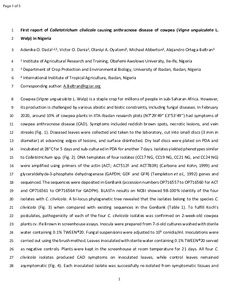| dc.contributor.author | Dada, A. |
| dc.contributor.author | Dania, V. |
| dc.contributor.author | Oyatomi, O. |
| dc.contributor.author | Abberton, M. |
| dc.contributor.author | Ortega-Beltran, A. |
| dc.date.accessioned | 2023-01-26T08:41:59Z |
| dc.date.available | 2023-01-26T08:41:59Z |
| dc.date.issued | 2022-12-21 |
| dc.identifier.citation | Dada, A., Dania, V., Oyatomi, O., Abberton, M. & Ortega-Beltran, A. (2022). First report of Colletotrichum cliviicola causing anthracnose disease of cowpea (Vigna unguiculata L. Walp) in Nigeria. Plant Disease, 1-5. |
| dc.identifier.issn | 0191-2917 |
| dc.identifier.uri | https://hdl.handle.net/20.500.12478/8028 |
| dc.description.abstract | Cowpea (Vigna unguiculata L. Walp) is a staple crop for millions of people in sub-Saharan Africa. However, its production is challenged by various abiotic and biotic constraints, including fungal diseases. In February 2020, around 10% of cowpea plants in IITA-Ibadan research plots (N7°29'49'' E3°53'49'') had symptoms of cowpea anthracnose disease (CAD). Symptoms included reddish brown spots, necrotic lesions, and vein streaks (Fig. 1). Diseased leaves were collected and taken to the laboratory, cut into small discs (3 mm in diameter) at advancing edges of lesions, and surface disinfected. Dry leaf discs were plated on PDA and incubated at 28°C for 5 days and sub-cultured in PDA for another 7 days. Isolates yielded phenotypes similar to Colletotrichum spp. (Fig. 2). DNA templates of four isolates (CC17 NG, CC19 NG, CC21 NG, and CC24 NG) were amplified using primers of the actin (ACT; ACT512F and ACT783R) (Carbone and Kohn, 1999) and glyceraldehyde-3-phosphate dehydrogenase (GAPDH; GDF and GFR) (Templeton et al., 1992) genes and sequenced. The sequences were deposited in GenBank (accession numbers OP716557 to OP716560 for ACT and OP716561 to OP716564 for GADPH). BLASTn results on NCBI showed 98-100% identity of the four isolates with C. cliviicola. A bi-locus phylogenetic tree revealed that the isolates belong to the species C. cliviicola (Fig. 3) when compared with existing sequences in the GenBank (Table 1). To fulfill Koch’s postulates, pathogenicity of each of the four C. cliviicola isolates was confirmed on 2-week-old cowpea plants cv. Ife Brown in screenhouse assays. Inocula were prepared from 7-d-old cultures washed with sterile water containing 0.1% TWEEN®20. Fungal suspensions were adjusted to 106 conidia/ml. Inoculations were carried out using the brush method. Leaves inoculated with sterile water containing 0.1% TWEEN®20 served as negative controls. Plants were kept in the screenhouse at room temperature for 21 days. All four C. cliviicola isolates produced CAD symptoms on inoculated leaves, while control leaves remained asymptomatic (Fig. 4). Each inoculated isolate was successfully re-isolated from symptomatic tissues and their identity confirmed. The fungus C. cliviicola is distributed in tropical and subtropical regions and has a wide host range, including several legumes (Damm et al. 2018). To our knowledge, this is the first report of C. cliviicola causing CAD in Nigeria and the world. There is the need to conduct a comprehensive distribution survey and develop appropriate control strategies in Nigeria. In addition, breeding for resistance to CAD in Nigeria should gear the efforts to all causal agents of the disease that occur across the country because historically CAD has been attributed to C. lindemuthianum and C. destructivum. |
| dc.format.extent | 1-5 |
| dc.language.iso | en |
| dc.subject | Cowpeas |
| dc.subject | Colletotrichum |
| dc.subject | Food Security |
| dc.subject | Plant Health |
| dc.subject | Nigeria |
| dc.subject | Anthracnosis |
| dc.title | First report of Colletotrichum cliviicola causing anthracnose disease of cowpea (Vigna unguiculata L. Walp) in Nigeria |
| dc.type | Journal Article |
| cg.contributor.crp | Genebanks |
| cg.contributor.crp | Maize |
| cg.contributor.crp | Roots, Tubers and Bananas |
| cg.contributor.affiliation | Obafemi Awolowo University |
| cg.contributor.affiliation | University of Ibadan |
| cg.contributor.affiliation | International Institute of Tropical Agriculture |
| cg.coverage.region | Africa |
| cg.coverage.region | West Africa |
| cg.coverage.country | Nigeria |
| cg.coverage.hub | Headquarters and Western Africa Hub |
| cg.researchtheme | Biotech and Plant Breeding |
| cg.researchtheme | Plant Production and Health |
| cg.isijournal | ISI Journal |
| cg.authorship.types | CGIAR and developing country institute |
| cg.iitasubject | Agronomy |
| cg.iitasubject | Cowpea |
| cg.iitasubject | Disease Control |
| cg.iitasubject | Food Security |
| cg.iitasubject | Grain Legumes |
| cg.iitasubject | Plant Breeding |
| cg.iitasubject | Plant Diseases |
| cg.iitasubject | Plant Health |
| cg.iitasubject | Plant Production |
| cg.journal | Plant Disease |
| cg.notes | Open Access Article; Published online: 21 Dec 2022 |
| cg.accessibilitystatus | Open Access |
| cg.reviewstatus | Peer Review |
| cg.usagerightslicense | Creative Commons Attribution 4.0 (CC BY 0.0) |
| cg.targetaudience | Scientists |
| cg.identifier.doi | https://dx.doi.org/10.1094/PDIS-10-22-2512-PDN |
| cg.iitaauthor.identifier | Olaniyi Oyatomi: 0000-0003-3094-374X |
| cg.iitaauthor.identifier | Michael Abberton: 0000-0003-2555-9591 |
| cg.iitaauthor.identifier | Alejandro Ortega-Beltran: 0000-0003-3747-8094 |
| cg.futureupdate.required | No |

